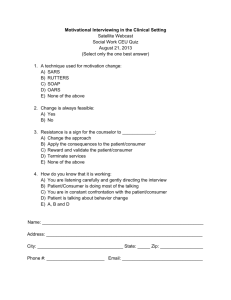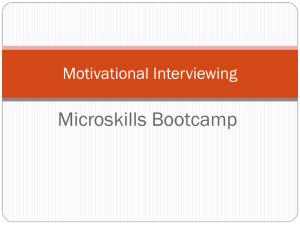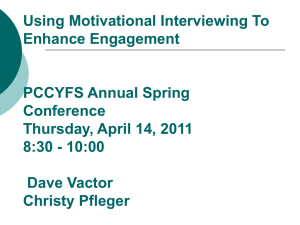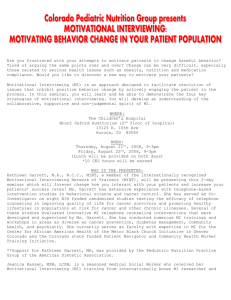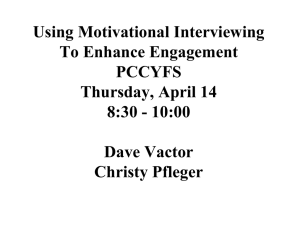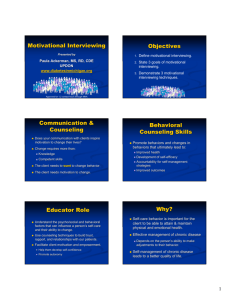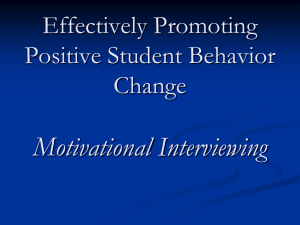2012 Jane Adult Because I Said So PFEIFERPrint
advertisement
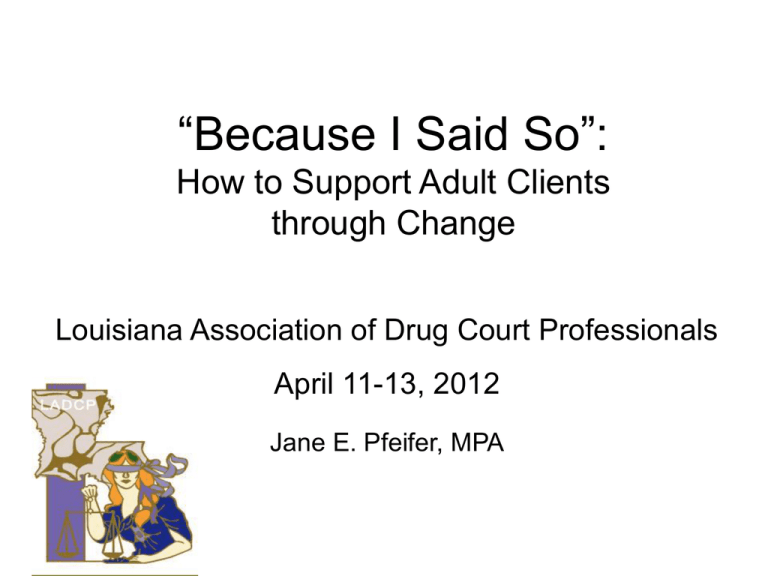
“Because I Said So”: How to Support Adult Clients through Change Louisiana Association of Drug Court Professionals April 11-13, 2012 Jane E. Pfeifer, MPA First Question: Q.: What agency/organization provides primary case management services for your Drug Court? Eight Evidence-Based Principles for Effective Interventions 1. Assess Actuarial Risk/Needs. 2. Enhance Intrinsic Motivation. 3. Target Interventions. 4. Skill Train with Directed Practice 5. Increase Positive Reinforcement. 6. Engage Ongoing Support in Natural Communities. 7. Measure Relevant Processes/Practices. 8. Provide Measurement Feedback NIC, 2004 2. Enhance Intrinsic Motivation • Use motivational techniques • Get training • Develop rapport with the participant • Avoid arguing! Engagement Whose job is it to engage the client? Engagement Engagement activities are intended to identify and fulfill the client's immediate needs, often with something as tangible as a pair of socks or a ride to the doctor. Center for Substance Abuse Treatment. Comprehensive Case Management for Substance Abuse Treatment. Rockville (MD): Substance Abuse and Mental Health Services Administration; 1998 (Treatment improvement protocol; no. 27). Increasing Motivation Whose job is it to assist the client in increasing his or her motivation? Increasing Motivation • Stages of Change • Motivational Strategies In a recent study, clients assigned to receive motivational interviewing techniques at intake had significantly better retention rates at the 28-day follow-up than clients who received the standard intake evaluation. (Carroll, et al., 2006.) Stages of Change Readiness (Prochaska and DiClemente, 1992) Precontemplation Maintenance Contemplation Action Preparation Stages of Change Contemplation Preparation Action Maintenance Relapse-Lapse-Change Pre-contemplation Stages of Change Pre-contemplation • • • • Not thinking about changing Happy user Learned helplessness Has no intention to take action within the next 6 months Stages of Change Contemplation • • • • Thinking about changing Ambivalence Chronic contemplators Intends to take action within the next 6 months. Stages of Change Preparation • • • • Decision made Firm plans Possibly recent attempts at change Intends to take action within the next 30 days. • Has taken some behavioral steps in this direction. Stages of Change Action • • • • • • • Overt behavioral change ‘Stopping’ main issue Grief issues Counter-conditioning Stimulus control Contingency management Has changed overt behavior for less than 6 months Stages of Change Maintenance • • • • Sustained behavior over time Alternatives established Later, becomes a non-issue Has changed overt behavior for more than 6 months. What is MOTIVATIONAL INTERVIEWING? • Intervention designed to mobilize client’s internal resources for change by enhancing intrinsic motivation. • A style of being with people, not just a set of techniques • An important goal is to clarify values and amplify discrepancies • Purpose is to move person through the stages of change from Morgenstern-”Motivational Interviewing” Philosophy of Motivational Interviewing • MI is a technique in which you become a helper – not a dictator – in the change process for your client. • In criminal justice we are used to telling people what to do. • This is a different style of interview and counseling. Goal Of Motivational Interviewing The goal of MI is to create a safe and supportive rapport with a person, in order to facilitate their thinking about their behavior and whether/how they might go about making changes. Confrontation: A Goal Not a Style AMBIVALENCE “I want to but I don’t want to” Important Assumptions in Motivational Interviewing • Clients are AMBIVALENT about changing. • There are BOTH pros AND cons to getting off of drugs vs. continuing to use. Ambivalence about quitting • We in criminal justice don’t typically see that for the client there are at least some good reasons to continue to use. • MI recognizes that ambivalence about quitting is NORMAL. Change Importance of Change A B I L I T Y Low importance: Low confidence Low importance: High confidence These people don’t see the need for change nor do they believe that could effectuate the change, if they decided to change These people are confident they can make the change but are not convinced that change is needed. T O High importance: Low confidence High importance: High confidence C H Here the problem is not the willingness A of the person to change but the person’s N confidence in their ability to change G E These people see the necessity of change and believe they can succeed. Exercise Share an example with your team of how you, in your role, can assist with increasing motivation. DEVELOPING DISCREPANCY • Motivation for change is enhanced when clients perceive the discrepancies between their current situations and behaviors, and their hopes and goals for the future. • Let the client present the argument for change. • “Tell me the good parts about using.” • “Tell me the negatives.” You will often hear about damaged family relationships, especially with the client’s children. • “How do these weigh out to you?” • “Where do you think you go from here?” Have the client state the solution of what he must do to achieve his stated goals, desires, wants, and wishes. Take Home Message: • Motivation to change is elicited from the client, and not imposed from without. • It is the client's task, not the interviewer’s, to articulate and resolve his or her ambivalence. Exercise • Pair up • Pick a real-life behavior change you want to make (be sure it’s one you want to share!) • One is the case manager and one is the drug court participant—then switch. • As the case manager, help your partner develop discrepancy. By the end, and without asking directly, see if you can determine if your partner is low importance/low ability; low importance/high ability; high importance/low ability; high importance/high ability. 3. Target Interventions a. Risk Principle: Prioritize supervision and treatment resources for higher risk offenders. b. Need Principle: Target interventions to criminogenic needs. c. Responsivity Principle: Be responsive to temperament, learning style, motivation, culture, and gender when assigning programs. Meeting Client’s Needs • “client’s” not “clients’” • What does this client need? • How do we know? – Assessment – Interviewing-ASK HER! • Comprehensive case management – Realistic case planning – Incremental objectives • Treatment matching – Gender appropriate – Culturally relevant What do Drug Court Participants need? What Goals Are Set For Clients? • Are there target behaviors that all clients must achieve? • Are they different in the beginning of the program? • Does your department/agency have differing goals for clients than the drug court, or are they consistent? • How individualized can goals be for each client? Exercise • As a team: – identify two strengths of your case management services. – identify two challenges with your case management process, and discuss possible solutions. Resources • Motivationalinterview.org • TIP 35: Enhancing Motivation for Change in Substance Abuse Treatment. • Motivational Interviewing, Second Edition, by William Miller • Miller and Rollnick, Motivational Interviewing: Preparing People for Change, (New York: Guilford Press 2002)

